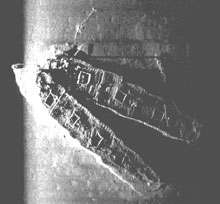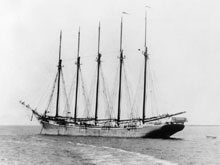
A 2002 sidescan image of the coal schooners Frank A. Palmer and Louise B. Crary. Of the 21 crew members of both vessels, only 10 survived the collision.
The Wreck of the Palmer and the Crary
Anne Smrcina
Education and Outreach Coordinator
Stellwagen Bank National Marine Sanctuary, NOAA
On December 17, 2002, the Stellwagen Bank National Marine Sanctuary released the first image of a dramatic 100-year-old maritime tragedy on the anniversary of the collision. Two schooners, the Frank A. Palmer and the Louise B. Crary, were bringing coal to Boston when they collided and sank. Sidescan sonar images collected in 2002 and 2003 clearly show the hulls of the two large sailing vessels, their bows locked together for all time. The positions of the wrecks, which are located within the sanctuary, are not being released at this time because a management plan for maritime heritage resources is not yet in place. To alleviate this situation, a working group to the Sanctuary Advisory Council will be addressing the issue of shipwreck management beginning in October 2003. A management plan that addresses all sanctuary resources, including shipwrecks, is scheduled to be released in 2004.
The story of the crash of the Frank A. Palmer and Louise B. Crary may never be fully understood. Nevertheless, survivors' testimony in the press, evidence in official reports, and visible information now provided by the wreck itself may povide a more complete picture of what happened that clear, cold night in December 1902.
According to the Crary captain’s testimony as reported by the Boston Globe and Boston Herald immediately following the accident, a miscalculation on the part of the Crary’s first mate, who was at the helm, led to the unfortunate collision. The evening was clear, although seas were far from calm. The bow of the Crary plowed into the portside of the Palmer, leaving both vessels fatally damaged. Reports state that the vessels disappeared from view quickly, with some of the Crary’s crew unable to abandon ship before it sank.
Of the 21 crew members from both schooners, 15 eventually made it into the Palmer’s longboat. A lifeboat from the Crary capsized during deployment, sending all five of its passengers into the water. Four of these fellows managed to make it to the Palmer longboat, however. Lack of communications prevented rescuers from learning of the collision, and the longboat drifted for four nights and three days until a fishing schooner from Duxbury, MA, spotted it many miles off Cape Cod. Of the original group of 15 survivors, four died from exposure and one committed suicide by jumping overboard.

Frank A. Palmer historic photo. Image courtesy Maine Historical Society.
The Palmer was the largest four-masted schooner ever built (274.5 ft) while the Crary was a similarly sized five-masted vessel (267 ft). Both were colliers (coal carriers), which plied regular routes between the coal-producing region in the Mid-Atlantic states and the energy-dependent northeast. In 1902, a record cold snap and a series of coastal storms created a serious energy crisis in Boston and throughout New England. Schools were closed to conserve energy. Regular home deliveries were disrupted. People stood in long lines to buy precious small quantities of coal at inflated rates. In Boston, the lead stories of the major papers focused on the bitter weather and unscrupulous price gouging. The Palmer, based out of Portland, ME, and the Crary, out of New York City were two of a fleet of vessels bringing coal to the beleaguered city.
The small cloud of steam visible on the starboard side of the Palmer in the historic photo above is from the “donkey engine.” Although the schooners were awkward to handle, the steam-powered engines provided power for hoisting the sails, running the windlass, capstan and pumps, and handling other heavy gear. With this early automation, the large coasters got by with relatively small crews (generally one or two mates, a steward, an engineer for the donkey engine, the captain, and a modest number of seamen based on the number of masts, generally two per “stick”). This was illustrated in the cases of the Palmer and Crary. Together, the two ships combined had only 21 officers and crew (10 for the Palmer and 11 for the Crary).
Rough sea conditions off the northeast coast had caused major delivery delays. Much of the coal fleet was standing by off Martha’s Vineyard, awaiting better sea conditions that would allow safer passage through Nantucket Shoals and around Cape Cod (this was before the creation of the Cape Cod Canal). Coal distributors in Boston and surrounding communities continued to raise prices for the scanty supplies.
Eventually, the weather broke and the fleet began streaming into Boston. By the time the Palmer and Crary rounded the Cape and started for Boston, numerous ships and barges had made their way into the harbor, alleviating some of the coal shortage. The large number of vessels waiting to offload their cargoes may have been a factor in the delay in noting the disappearance of the two schooners. It was not until December 20 (almost three days after they sank) that questions of the ships’ whereabouts appeared in the papers. Shortly after that, the longboat was sighted and the survivors were brought back to Boston.

Louise B. Crary historic photo. Image courtesy of Maine Historical Society.
Besides the lack of ship-to-shore communications, another factor involved in the tragedy was the nature of coastal shipping at the time and the dearth of voices on shore demanding an accounting of the ships’ arrival times. Most of the crews of this workhorse fleet were recent immigrants, many having come from Scandinavia and Eastern Europe. Many of these men had no family members nearby; many did not speak English. The Palmer and Crary were a microcosm of the larger community, with both Captains having American roots, but the crews representing Sweden, Norway, Germany, Portugal, Greece, Newfoundland (Canada), and South America.
The Crary and other large, multi-masted schooners were designed to compete against the barge lines and carry large, heavy cargoes. The ships were long and narrow, which provided for speed when the wind was good, but were unwieldy in other conditions. The bows were moderately sharp, and the floors were long and flat. These characteristics may have played a role in the crash and quick sinking of the ships on the night of December 17, 1902.
The Palmer-Crary shipwreck was originally located over 13 years ago when John Fish and Arnie Carr of American Underwater Search and Survey (AUSS) located it during their search for the steamship Portland. When their sidescan images showed it was not the famed steamship but the two ill-fated colliers, they kept a record of the find. As the 2002 NOAA cruise to confirm the location of the Portland (another one of their finds) was being planned, Fish and Carr again generously provided the wreck coordinates.
The wrecks' resting place within the sanctuary’s boundaries means affords them a level of protection unavailable in other federal and international waters off Massachusetts. Sanctuary regulations prohibit moving, removing, or injuring, or attempting to move, remove, or injure, any submerged cultural or historical resources, including artifacts and pieces of shipwrecks (unless under permit). Anyone violating these regulations is subject to civil penalties.

















